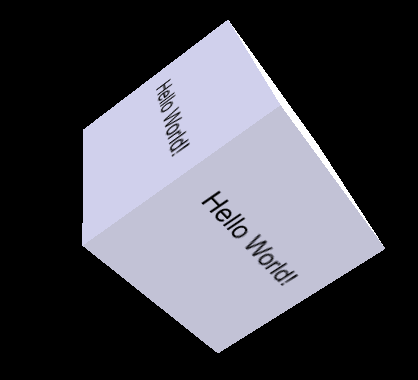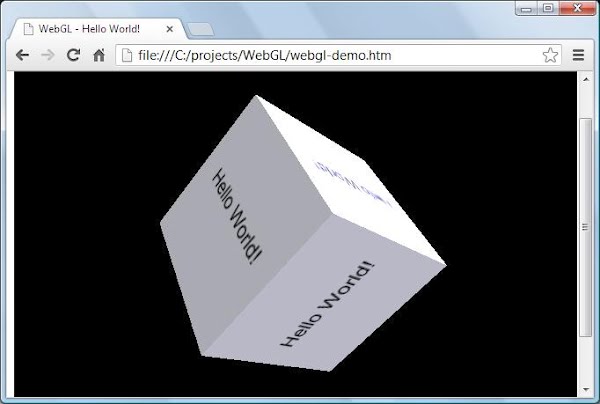前提條件和預期結果
目前只有少數的浏覽器支持 WebGL ,請看我的另外一篇文章:Can I use WebGL?.
下面的例子是在 Windows 下的 Chrome 16/23 以及 Android 下的 Firefox 17 進行測試。如果你使用的是非兼容浏覽器訪問則會彈出一個警告。

圖1:包含 Hello world 文本的動畫的 WebGL 立方體
在兼容 HTML5 的浏覽器上,你將會看到如下圖所示的帶動畫效果的立方體:

圖2: 示例運行的屏幕截圖
該代碼基於 Lighting in WebGL - How to simulate lighting effects in your WebGL context - 非常感謝這篇教程。在該實例初始運行時,動畫的立方體是通過一個靜態的 Bitmap 圖形對象渲染的。
下面的代碼演示如何在程序中動態的渲染文本:
XML/HTML Code復制內容到剪貼板
// TODO #1 New method to create a texture
function createCubeTexture(text) {
...
}
在這裡使用 gl.pixelStorei(gl.UNPACK_FLIP_Y_WEBGL, true); 是非常重要的,用來確保寫文本時不會前後顛倒。剩下的就很容易理解了:
XML/HTML Code復制內容到剪貼板
// TODO #2 Assign the created texture for display
cubeTexture = createCubeTexture("Hello World!");
源碼
// File #1: webgl-demo.htm
XML/HTML Code復制內容到剪貼板- <html>
- <head>
- <title>WebGL - Hello World!</title>
- <meta http-equiv="Content-Type" content="text/html; charset=utf-8">
- <script src="sylvester.js" type="text/javascript"></script>
- <script src="glUtils.js" type="text/javascript"></script>
- <script src="webgl-demo.js" type="text/javascript"></script>
- <!-- Fragment shader program -->
- <script id="shader-fs" type="x-shader/x-fragment">
- varying highp vec2 vTextureCoord;
- varying highp vec3 vLighting;
- uniform sampler2D uSampler;
- void main(void) {
- highp vec4 texelColor = texture2D(uSampler, vec2(vTextureCoord.s, vTextureCoord.t));
- gl_FragColor = vec4(texelColor.rgb * vLighting, texelColor.a);
- }
- </script>
- <!-- Vertex shader program -->
- <script id="shader-vs" type="x-shader/x-vertex">
- attribute highp vec3 aVertexNormal;
- attribute highp vec3 aVertexPosition;
- attribute highp vec2 aTextureCoord;
- uniform highp mat4 uNormalMatrix;
- uniform highp mat4 uMVMatrix;
- uniform highp mat4 uPMatrix;
- varying highp vec2 vTextureCoord;
- varying highp vec3 vLighting;
- void main(void) {
- gl_Position = uPMatrix * uMVMatrix * vec4(aVertexPosition, 1.0);
- vTextureCoord = aTextureCoord;
- // Apply lighting effect
- highp vec3 ambientLight = vec3(0.6, 0.6, 0.6);
- highp vec3 directionalLightColor = vec3(0.5, 0.5, 0.75);
- highp vec3 directionalVector = vec3(0.85, 0.8, 0.75);
- highp vec4 transformedNormal = uNormalMatrix * vec4(aVertexNormal, 1.0);
- highp float directional = max(dot(transformedNormal.xyz, directionalVector), 0.0);
- vLighting = ambientLight + (directionalLightColor * directional);
- }
- </script>
- </head>
- <body onload="start()">
- <canvas id="glcanvas" width="640" height="480">
- Your browser doesn't appear to support the HTML5 <code><canvas></code> element.
- </canvas>
- </body>
- </html>
// File #02: webgl-demo.js
XML/HTML Code復制內容到剪貼板
var canvas;
var gl;
var cubeVerticesBuffer;
var cubeVerticesTextureCoordBuffer;
var cubeVerticesIndexBuffer;
var cubeVerticesIndexBuffer;
var cubeRotation = 0.0;
var lastCubeUpdateTime = 0;
var cubeImage;
var cubeTexture;
var mvMatrix;
var shaderProgram;
var vertexPositionAttribute;
var vertexNormalAttribute;
var textureCoordAttribute;
var perspectiveMatrix;
//
// start
//
// Called when the canvas is created to get the ball rolling.
//
function start() {
canvas = document.getElementById("glcanvas");
initWebGL(canvas); // Initialize the GL context
// Only continue if WebGL is available and working
if (gl) {
gl.clearColor(0.0, 0.0, 0.0, 1.0); // Clear to black, fully opaque
gl.clearDepth(1.0); // Clear everything
gl.enable(gl.DEPTH_TEST); // Enable depth testing
gl.depthFunc(gl.LEQUAL); // Near things obscure far things
// Initialize the shaders; this is where all the lighting for the
// vertices and so forth is established.
initShaders();
// Here's where we call the routine that builds all the objects
// we'll be drawing.
initBuffers();
// Next, load and set up the textures we'll be using.
// TODO#2 Start
cubeTexture = createCubeTexture("Hello World!");
// TODO#2 End
// Set up to draw the scene periodically.
setInterval(drawScene, 15);
}
}
//
// initWebGL
//
// Initialize WebGL, returning the GL context or null if
// WebGL isn't available or could not be initialized.
//
function initWebGL() {
gl = null;
try {
gl = canvas.getContext("experimental-webgl");
}
catch(e) {
}
// If we don't have a GL context, give up now
if (!gl) {
alert("Unable to initialize WebGL. Your browser may not support it.");
}
}
//
// initBuffers
//
// Initialize the buffers we'll need. For this demo, we just have
// one object -- a simple two-dimensional cube.
//
function initBuffers() {
// Create a buffer for the cube's vertices.
cubeVerticesBuffer = gl.createBuffer();
// Select the cubeVerticesBuffer as the one to apply vertex
// operations to from here out.
gl.bindBuffer(gl.ARRAY_BUFFER, cubeVerticesBuffer);
// Now create an array of vertices for the cube.
var vertices = [
// Front face
-1.0, -1.0, 1.0,
1.0, -1.0, 1.0,
1.0, 1.0, 1.0,
-1.0, 1.0, 1.0,
// Back face
-1.0, -1.0, -1.0,
-1.0, 1.0, -1.0,
1.0, 1.0, -1.0,
1.0, -1.0, -1.0,
// Top face
-1.0, 1.0, -1.0,
-1.0, 1.0, 1.0,
1.0, 1.0, 1.0,
1.0, 1.0, -1.0,
// Bottom face
-1.0, -1.0, -1.0,
1.0, -1.0, -1.0,
1.0, -1.0, 1.0,
-1.0, -1.0, 1.0,
// Right face
1.0, -1.0, -1.0,
1.0, 1.0, -1.0,
1.0, 1.0, 1.0,
1.0, -1.0, 1.0,
// Left face
-1.0, -1.0, -1.0,
-1.0, -1.0, 1.0,
-1.0, 1.0, 1.0,
-1.0, 1.0, -1.0
];
// Now pass the list of vertices into WebGL to build the shape. We
// do this by creating a Float32Array from the JavaScript array,
// then use it to fill the current vertex buffer.
gl.bufferData(gl.ARRAY_BUFFER, new Float32Array(vertices), gl.STATIC_DRAW);
// Set up the normals for the vertices, so that we can compute lighting.
cubeVerticesNormalBuffer = gl.createBuffer();
gl.bindBuffer(gl.ARRAY_BUFFER, cubeVerticesNormalBuffer);
var vertexNormals = [
// Front
0.0, 0.0, 1.0,
0.0, 0.0, 1.0,
0.0, 0.0, 1.0,
0.0, 0.0, 1.0,
// Back
0.0, 0.0, -1.0,
0.0, 0.0, -1.0,
0.0, 0.0, -1.0,
0.0, 0.0, -1.0,
// Top
0.0, 1.0, 0.0,
0.0, 1.0, 0.0,
0.0, 1.0, 0.0,
0.0, 1.0, 0.0,
// Bottom
0.0, -1.0, 0.0,
0.0, -1.0, 0.0,
0.0, -1.0, 0.0,
0.0, -1.0, 0.0,
// Right
1.0, 0.0, 0.0,
1.0, 0.0, 0.0,
1.0, 0.0, 0.0,
1.0, 0.0, 0.0,
// Left
-1.0, 0.0, 0.0,
-1.0, 0.0, 0.0,
-1.0, 0.0, 0.0,
-1.0, 0.0, 0.0
];
gl.bufferData(gl.ARRAY_BUFFER, new Float32Array(vertexNormals),
gl.STATIC_DRAW);
// Map the texture onto the cube's faces.
cubeVerticesTextureCoordBuffer = gl.createBuffer();
gl.bindBuffer(gl.ARRAY_BUFFER, cubeVerticesTextureCoordBuffer);
var textureCoordinates = [
// Front
0.0, 0.0,
1.0, 0.0,
1.0, 1.0,
0.0, 1.0,
// Back
0.0, 0.0,
1.0, 0.0,
1.0, 1.0,
0.0, 1.0,
// Top
0.0, 0.0,
1.0, 0.0,
1.0, 1.0,
0.0, 1.0,
// Bottom
0.0, 0.0,
1.0, 0.0,
1.0, 1.0,
0.0, 1.0,
// Right
0.0, 0.0,
1.0, 0.0,
1.0, 1.0,
0.0, 1.0,
// Left
0.0, 0.0,
1.0, 0.0,
1.0, 1.0,
0.0, 1.0
];
gl.bufferData(gl.ARRAY_BUFFER, new Float32Array(textureCoordinates),
gl.STATIC_DRAW);
// Build the element array buffer; this specifies the indices
// into the vertex array for each face's vertices.
cubeVerticesIndexBuffer = gl.createBuffer();
gl.bindBuffer(gl.ELEMENT_ARRAY_BUFFER, cubeVerticesIndexBuffer);
// This array defines each face as two triangles, using the
// indices into the vertex array to specify each triangle's
// position.
var cubeVertexIndices = [
0, 1, 2, 0, 2, 3, // front
4, 5, 6, 4, 6, 7, // back
8, 9, 10, 8, 10, 11, // top
12, 13, 14, 12, 14, 15, // bottom
16, 17, 18, 16, 18, 19, // right
20, 21, 22, 20, 22, 23 // left
]
// Now send the element array to GL
gl.bufferData(gl.ELEMENT_ARRAY_BUFFER,
new Uint16Array(cubeVertexIndices), gl.STATIC_DRAW);
}
//
// initTextures
//
// Initialize the textures we'll be using, then initiate a load of
// the texture images. The handleTextureLoaded() callback will finish
// the job; it gets called each time a texture finishes loading.
//
// TODO#1 Start
function createCubeTexture(text) {
// create a hidden canvas to draw the texture
var canvas = document.createElement('canvas');
canvas.id = "hiddenCanvas";
canvas.width = 512;
canvas.height = 512;
canvas.style.display = "none";
var body = document.getElementsByTagName("body")[0];
body.appendChild(canvas);
// draw texture
var cubeImage = document.getElementById('hiddenCanvas');
var ctx = cubeImage.getContext('2d');
ctx.beginPath();
ctx.rect(0, 0, ctx.canvas.width, ctx.canvas.height);
ctx.fillStyle = 'white';
ctx.fill();
ctx.fillStyle = 'black';
ctx.font = "65px Arial";
ctx.textAlign = 'center';
ctx.fillText(text, ctx.canvas.width / 2, ctx.canvas.height / 2);
ctx.restore();
// create new texture
var texture = gl.createTexture();
gl.bindTexture(gl.TEXTURE_2D, texture);
gl.texParameteri(gl.TEXTURE_2D, gl.TEXTURE_MAG_FILTER, gl.LINEAR);
gl.texParameteri(gl.TEXTURE_2D, gl.TEXTURE_MIN_FILTER, gl.LINEAR_MIPMAP_NEAREST);
gl.pixelStorei(gl.UNPACK_FLIP_Y_WEBGL, true);
handleTextureLoaded(cubeImage, texture)
return texture;
}
// TODO#1 End
function handleTextureLoaded(image, texture) {
gl.bindTexture(gl.TEXTURE_2D, texture);
gl.texImage2D(gl.TEXTURE_2D, 0, gl.RGBA, gl.RGBA, gl.UNSIGNED_BYTE, image);
gl.texParameteri(gl.TEXTURE_2D, gl.TEXTURE_MAG_FILTER, gl.LINEAR);
gl.texParameteri(gl.TEXTURE_2D, gl.TEXTURE_MIN_FILTER, gl.LINEAR_MIPMAP_NEAREST);
gl.generateMipmap(gl.TEXTURE_2D);
gl.bindTexture(gl.TEXTURE_2D, null);
}
//
// drawScene
//
// Draw the scene.
//
function drawScene() {
// Clear the canvas before we start drawing on it.
gl.clear(gl.COLOR_BUFFER_BIT | gl.DEPTH_BUFFER_BIT);
// Establish the perspective with which we want to view the
// scene. Our field of view is 45 degrees, with a width/height
// ratio of 640:480, and we only want to see objects between 0.1 units
// and 100 units away from the camera.
perspectiveMatrix = makePerspective(45, 640.0/480.0, 0.1, 100.0);
// Set the drawing position to the "identity" point, which is
// the center of the scene.
loadIdentity();
// Now move the drawing position a bit to where we want to start
// drawing the cube.
mvTranslate([0.0, 0.0, -6.0]);
// Save the current matrix, then rotate before we draw.
mvPushMatrix();
mvRotate(cubeRotation, [1, 0, 1]);
// Draw the cube by binding the array buffer to the cube's vertices
// array, setting attributes, and pushing it to GL.
gl.bindBuffer(gl.ARRAY_BUFFER, cubeVerticesBuffer);
gl.vertexAttribPointer(vertexPositionAttribute, 3, gl.FLOAT, false, 0, 0);
// Set the texture coordinates attribute for the vertices.
gl.bindBuffer(gl.ARRAY_BUFFER, cubeVerticesTextureCoordBuffer);
gl.vertexAttribPointer(textureCoordAttribute, 2, gl.FLOAT, false, 0, 0);
// Bind the normals buffer to the shader attribute.
gl.bindBuffer(gl.ARRAY_BUFFER, cubeVerticesNormalBuffer);
gl.vertexAttribPointer(vertexNormalAttribute, 3, gl.FLOAT, false, 0, 0);
// Specify the texture to map onto the faces.
gl.activeTexture(gl.TEXTURE0);
gl.bindTexture(gl.TEXTURE_2D, cubeTexture);
gl.uniform1i(gl.getUniformLocation(shaderProgram, "uSampler"), 0);
// Draw the cube.
gl.bindBuffer(gl.ELEMENT_ARRAY_BUFFER, cubeVerticesIndexBuffer);
setMatrixUniforms();
gl.drawElements(gl.TRIANGLES, 36, gl.UNSIGNED_SHORT, 0);
// Restore the original matrix
mvPopMatrix();
// Update the rotation for the next draw, if it's time to do so.
var currentTime = (new Date).getTime();
if (lastCubeUpdateTime) {
var delta = currentTime - lastCubeUpdateTime;
cubeRotation += (30 * delta) / 1000.0;
}
lastCubeUpdateTime = currentTime;
}
//
// initShaders
//
// Initialize the shaders, so WebGL knows how to light our scene.
//
function initShaders() {
var fragmentShader = getShader(gl, "shader-fs");
var vertexShader = getShader(gl, "shader-vs");
// Create the shader program
shaderProgram = gl.createProgram();
gl.attachShader(shaderProgram, vertexShader);
gl.attachShader(shaderProgram, fragmentShader);
gl.linkProgram(shaderProgram);
// If creating the shader program failed, alert
if (!gl.getProgramParameter(shaderProgram, gl.LINK_STATUS)) {
alert("Unable to initialize the shader program.");
}
gl.useProgram(shaderProgram);
vertexPositionAttribute = gl.getAttribLocation(shaderProgram, "aVertexPosition");
gl.enableVertexAttribArray(vertexPositionAttribute);
textureCoordAttribute = gl.getAttribLocation(shaderProgram, "aTextureCoord");
gl.enableVertexAttribArray(textureCoordAttribute);
vertexNormalAttribute = gl.getAttribLocation(shaderProgram, "aVertexNormal");
gl.enableVertexAttribArray(vertexNormalAttribute);
}
//
// getShader
//
// Loads a shader program by scouring the current document,
// looking for a script with the specified ID.
//
function getShader(gl, id) {
var shaderScript = document.getElementById(id);
// Didn't find an element with the specified ID; abort.
if (!shaderScript) {
return null;
}
// Walk through the source element's children, building the
// shader source string.
var theSource = "";
var currentChild = shaderScript.firstChild;
while(currentChild) {
if (currentChild.nodeType == 3) {
theSource += currentChild.textContent;
}
currentChildcurrentChild = currentChild.nextSibling;
}
// Now figure out what type of shader script we have,
// based on its MIME type.
var shader;
if (shaderScript.type == "x-shader/x-fragment") {
shader = gl.createShader(gl.FRAGMENT_SHADER);
} else if (shaderScript.type == "x-shader/x-vertex") {
shader = gl.createShader(gl.VERTEX_SHADER);
} else {
return null; // Unknown shader type
}
// Send the source to the shader object
gl.shaderSource(shader, theSource);
// Compile the shader program
gl.compileShader(shader);
// See if it compiled successfully
if (!gl.getShaderParameter(shader, gl.COMPILE_STATUS)) {
alert("An error occurred compiling the shaders: " + gl.getShaderInfoLog(shader));
return null;
}
return shader;
}
//
// Matrix utility functions
//
function loadIdentity() {
mvMatrix = Matrix.I(4);
}
function multMatrix(m) {
mvMatrixmvMatrix = mvMatrix.x(m);
}
function mvTranslate(v) {
multMatrix(Matrix.Translation($V([v[0], v[1], v[2]])).ensure4x4());
}
function setMatrixUniforms() {
var pUniform = gl.getUniformLocation(shaderProgram, "uPMatrix");
gl.uniformMatrix4fv(pUniform, false, new Float32Array(perspectiveMatrix.flatten()));
var mvUniform = gl.getUniformLocation(shaderProgram, "uMVMatrix");
gl.uniformMatrix4fv(mvUniform, false, new Float32Array(mvMatrix.flatten()));
var normalMatrix = mvMatrix.inverse();
normalMatrixnormalMatrix = normalMatrix.transpose();
var nUniform = gl.getUniformLocation(shaderProgram, "uNormalMatrix");
gl.uniformMatrix4fv(nUniform, false, new Float32Array(normalMatrix.flatten()));
}
var mvMatrixStack = [];
function mvPushMatrix(m) {
if (m) {
mvMatrixStack.push(m.dup());
mmvMatrix = m.dup();
} else {
mvMatrixStack.push(mvMatrix.dup());
}
}
function mvPopMatrix() {
if (!mvMatrixStack.length) {
throw("Can't pop from an empty matrix stack.");
}
mvMatrix = mvMatrixStack.pop();
return mvMatrix;
}
function mvRotate(angle, v) {
var inRadians = angle * Math.PI / 180.0;
var m = Matrix.Rotation(inRadians, $V([v[0], v[1], v[2]])).ensure4x4();
multMatrix(m);
}